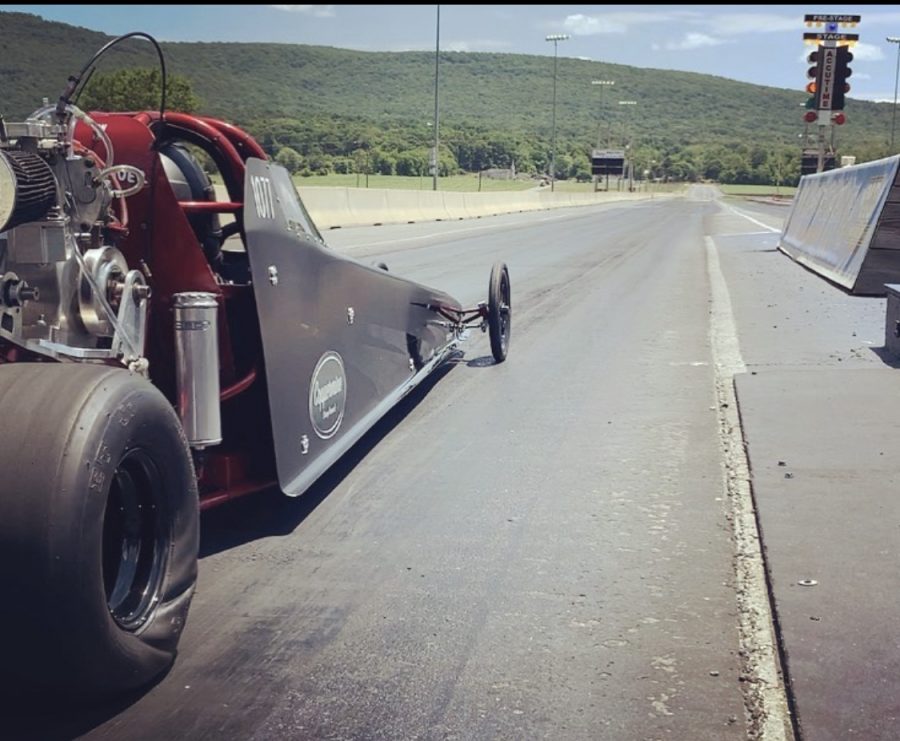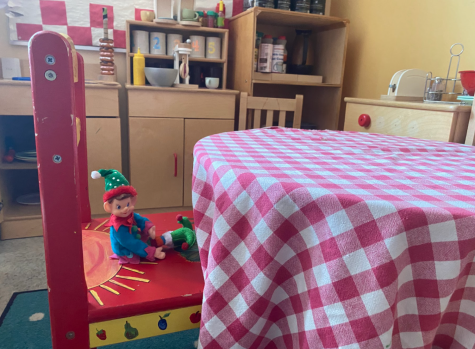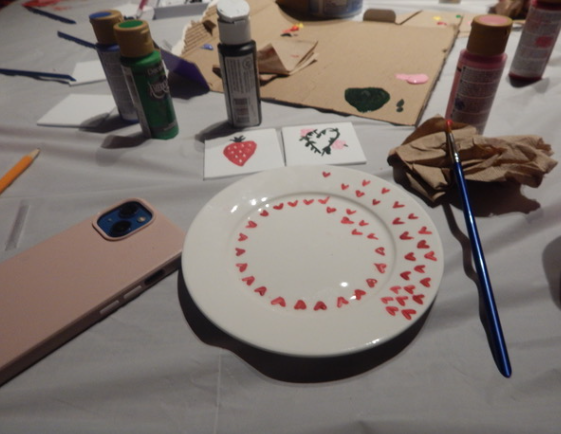Ready, Set, Go!: A look inside drag racing
Get all the information you need here
Look at that wrinkle in my tire: makes me love the smell of rubber.
When most kids are just learning to ride a bike, the children in my family were in junior dragsters, driving as “slow” as 45 mph in 11.90 seconds.
By the time I was 13, I was regularly driving 85 mph in 7.90 seconds.
A dragster looks a little like the wedge you stick under a door, with small lightweight wheels in front and a heavy engine and fat tires in the back. The junior driver sits in front of the engine, typically running about 60-70 horsepower.
I got many lessons from my sister and brother on what techniques they thought would be the best for me. We went over every little detail. It really did make me into the racer I am today. For example, we have a certain way to stage for a race. These tricks help me to be more consistent.
I had to race many of my friends that are very good. It is very difficult to race someone that you are really close with. I actually met my boyfriend through racing. I raced him, and after that race, we just started to click. (I can’t tell you who won because we are still disagreeing on that.)
You can always tell who your friends from racing are always going to be, just by the way that everyone all clicks during race day.
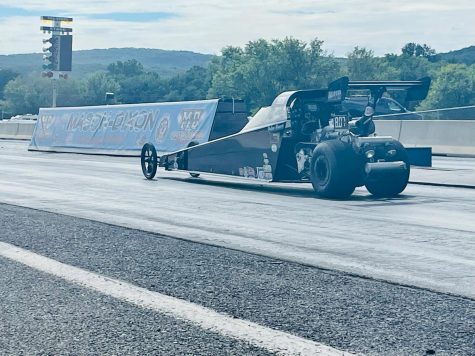
My boyfriend, FSK senior Dylan Moore, originally started his racing career at 9 years old. He races a 1984 Fox Body Mustang. It has a 306 Ford motor, and runs 94 mph in 7.60 seconds. He also races a Junior Dragster like me.
There are several other people in his family that race as well. Once one family member starts to race, it’s likely the whole family gets involved. His grandfather, dad, and uncle all race.
Through all the money and adventures, none of his family could see them doing anything else in life. Drag racing has been a part of their family for generations as long as my family. I have raced for seven years now, so I can relate to them all.
The general week for us is filled with hot days and long cold nights.
We start the week by pulling the cars out of the garage. We have to change the oil in the cars and look over everything to make sure nothing is wrong. They always go and check on the motor by starting it and make sure nothing sounds wrong or out of the normal.
This requires more than one garage or trailer and a very big driveway.
Moore has always dreamed of going to big money races. We want to eventually travel the world to races. Big money means over $10,000 for the winner.
My car was originally a Christmas present, a very expensive one, that has been handed down from both my brother (25) , to sister (22), to me.
History
Racing has changed a lot over the years. Drag Racing was originally created in the 1930s on dry lake beds in southern California and now they’re made with smooth asphalt and rubber.
Back in the 1930s, they didn’t have gates and barriers for spectators to protect themselves. Nowadays spectators have fences, barriers, and bleachers to sit in.
It wasn’t until after World War II when drag racing became an actual sport/activity.
The 1960s saw racing get more technical when the traditional race starter (flagman) was replaced with an electronic light system. Volunteer crew members were suddenly paid wages and trailers became mobile garages.
The National Hot Rod Association (NHRA) was founded in 1951 by Wally Parks. The National Hot Rod Association became a racing association that would give out money prizes. As time went on, NHRA got sponsors with bigger corporations and were able to give out bigger money prizes.
Ready, Set , Go!
To race, racers line up in parallel lines at an electronic starting device known as a Christmas tree. Each driver interrupts a pair of infrared beams on their approach to the starting line. First they turn on the pre-staging light then turn on the stage lights. Once both vehicles are completely staged and are stationary, a starter flips a switch to activate the tree.
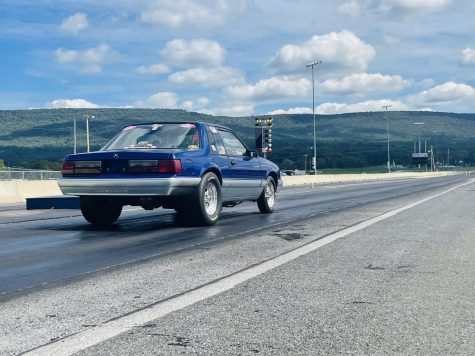
There are three amber lights on a tree and two types of racing: heads up and bracket. When all three come on at once, heads up racers leave on green “Go” light.
Bracket racing is what I do and so does Moore. This is when one amber light drops at a time. Racers leave on the third amber light right before the green light comes on. Leaving prematurely gives you a “red” light which disqualifies you.
It is a race to the finish line; the finish line can be ¼ mile away or ⅛ mile away. You have to dial your car. based on the “test runs” and whatever your car seems to run, put that time on your car. If you are the slower car than your opponent, you get a head start.
Bracket racing isn’t about who gets there first. It’s about who gets to the finish line first and runs closest to their “dial.”
Cha ching!
Moore has won many races in his years, he once said, “It might seem like I win a lot but believe me it is not the easiest sport to understand. Go and ask the best racers you can find and they will all tell you, “ ‘You will lose more than you will win.’ I was taught that my whole life with racing, it’s what keeps me going.”
Every racer has tough race days or weekends, some come home with money or a trophy and some come home with nothing. It doesn’t matter if you are really good at racing or not, everyone has off days. Drag racing is a sport that has a lot to do with having good luck.
When my dad bought my Junior Dragster, with a motor and the suit and the whole set up costs up to a little over $18,000. Racing a “big car” known as a door car or a Dragster. You can spend over $50,000 if lots of time and money is put in to it.
It can be very expensive if something were to go wrong in the motor, to rebuild a motor costs about $4,000 in labor costs. Also having to buy drag slicks can cost up to $200 a piece. To buy really nice rims as well, those can cost up to $1,000 a piece.
You have to buy seat belts, seats, and all the buttons and switches in the car as well. It takes a lot of time to finish a race car. I know some people that have over $100,000 put into their cars to race.
Race Ready!
Drag racing is an overall fun sport to get yourself involved in, but racers always want to make sure that they get the best understanding of the sport before they put time and money into it. Some people take a very big interest in it and others don’t. So take a look into it to find out for yourself if racing is something you could take an interest in.
I grew up going to 75/80 Dragway but they closed down a couple years ago so I race at Mason Dixon Dragway full time now.
Mason Dixon Dragway is located in Boonsboro, MD. This is also where Moore races a lot, too, we call it our “home track”. It means where racers, race the most for many weekends in a row.
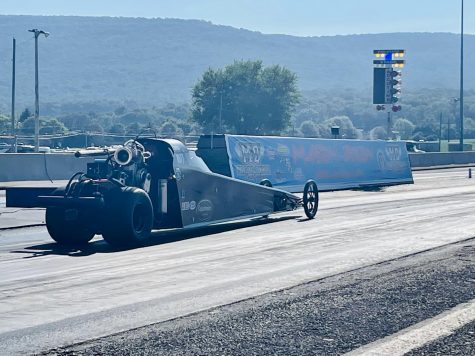
Spectators usually cost $15-$20 and they tend to race on Sundays more than Saturdays. They race more than one day a weekend sometimes but we tend to race Sundays. Junior Dragster usually start at 9:30 and big cars tend to start at 11:30.
Come in and enjoy yourself, watch some races and get the feel for it. See the real inside look on it. Also see if it is entertaining for you.
Your donation will support the student journalists of Linganore High School. Your contribution will allow us to purchase camera/recording equipment and software. We hope to raise enough money to re-start a monthly printed issue of our paper.


